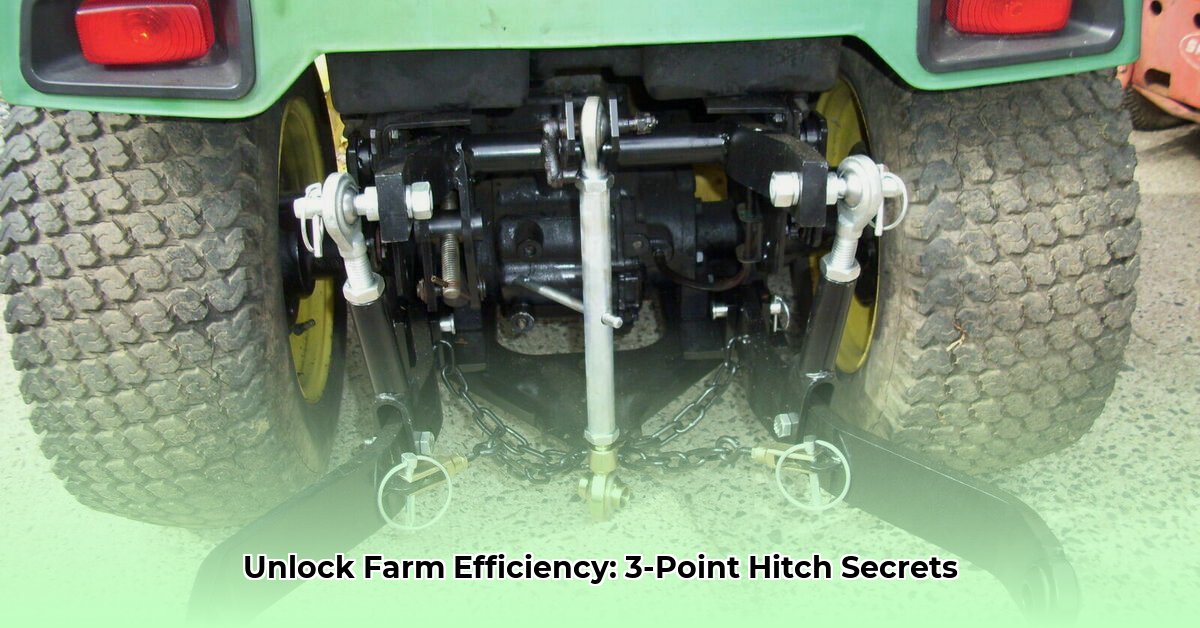
Understanding Your 3-Point Hitch Lawn Tractor
A three-point hitch (3PH) on a lawn tractor transforms it into a versatile workhorse for various farm tasks. This system, located at the rear, allows for quick connection and disconnection of implements like tillers, mowers, and plows. Many brands utilize a standardized system, increasing compatibility, but always verify compatibility before purchasing to ensure a proper fit. Improperly matched equipment can lead to decreased efficiency and potential equipment damage. What are the most common issues you encounter with 3-point hitches? For more information on lawn tractor maintenance, check out this helpful resource.
Choosing the Right Implements: Sustainability and Efficiency
Selecting appropriate implements is critical for both efficiency and sustainable farming practices. While heavy-duty implements might seem faster, they can severely compact soil, reducing water retention and nutrient uptake, negatively affecting crop yields. Lighter implements are generally preferred for soil health.
Here's a breakdown of implement selection considerations:
- Weight: Lighter implements are preferable for minimizing soil compaction. Avoid excessively heavy implements unless absolutely necessary.
- Task Specificity: Choose implements designed for your specific tasks (tilling, mowing, plowing, etc.). Using the wrong tool reduces efficiency and may damage the implement or your soil.
- Compatibility: Always confirm implement compatibility with your specific 3-point hitch model. Check manufacturer specifications carefully to avoid costly mistakes and potential safety hazards.
Preparing Your 3-Point Hitch: Safety First
Before using your 3PH, a pre-operational inspection is crucial for safe and efficient operation. This simple process can prevent significant problems.
- Hitch Inspection: Carefully examine the hitch for any signs of wear, damage, or loose pins. Replace damaged parts immediately. Ignoring this step could lead to catastrophic equipment failure.
- Hydraulic Fluid Check: Low hydraulic fluid levels impact performance. Check fluid levels and top them off using the correct type and amount specified in your owner's manual.
- Lift Test: Raise and lower the hitch arms several times to ensure smooth operation. Any unusual noises or resistance indicates a problem; do not proceed until the issue is resolved.
Maximizing Efficiency: Strategies for Optimal Use
Several strategies can maximize your 3PH tractor's potential and improve your overall farm efficiency.
- Smart Implement Selection: Optimize your workflow by selecting implements that allow you to complete tasks in the fewest passes. This saves time and fuel.
- Conservation Tillage: Employ conservation tillage techniques to minimize soil disturbance and maintain soil health. These methods often involve leaving crop residue on the soil surface. How much fuel savings have you experienced using conservation tillage?
- Strategic Planning: Plan your work in advance to optimize routes and reduce wasted time and fuel.
Managing Potential Risks: A Realistic Assessment
While 3-point hitches offer great utility, understanding potential risks is essential for safe operation. The following risk assessment matrix outlines potential issues and mitigation strategies:
| Risk | Likelihood | Impact | Mitigation |
|---|---|---|---|
| Soil Compaction | Medium | High | Use lighter implements; employ conservation tillage. |
| Implement Incompatibility | High | Medium | Verify compatibility before purchase; consult manuals. |
| Equipment Malfunction | Low | High | Perform regular maintenance; conduct pre-operational checks. |
| Fuel Consumption | Medium | Medium | Optimize tractor usage; choose efficient implements; practice fuel-efficient driving techniques. |
Long-Term Vision: Sustainable Farming Practices
Investing in a 3-point hitch tractor is a long-term commitment. For success, consider:
- Gradual Implementation: Begin with smaller projects to gain experience before tackling larger tasks. This approach minimizes the risk of errors and allows you to learn the system's capabilities.
- Continuous Learning: Stay informed on best practices through workshops, online resources, and industry publications. The field of sustainable agriculture is constantly evolving.
- Preventative Maintenance: Regular maintenance prevents costly repairs and prolongs the life of your equipment. Adhere to your owner’s manual's recommended maintenance schedule.
By employing these strategies and understanding the potential risks, you can maximize the efficiency and sustainability of your farming operations using a 3-point hitch lawn tractor. Remember, working smarter, not harder, is key to a more profitable and environmentally responsible future.